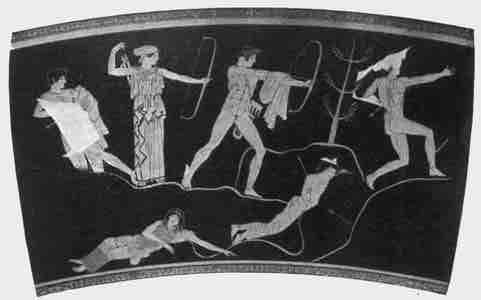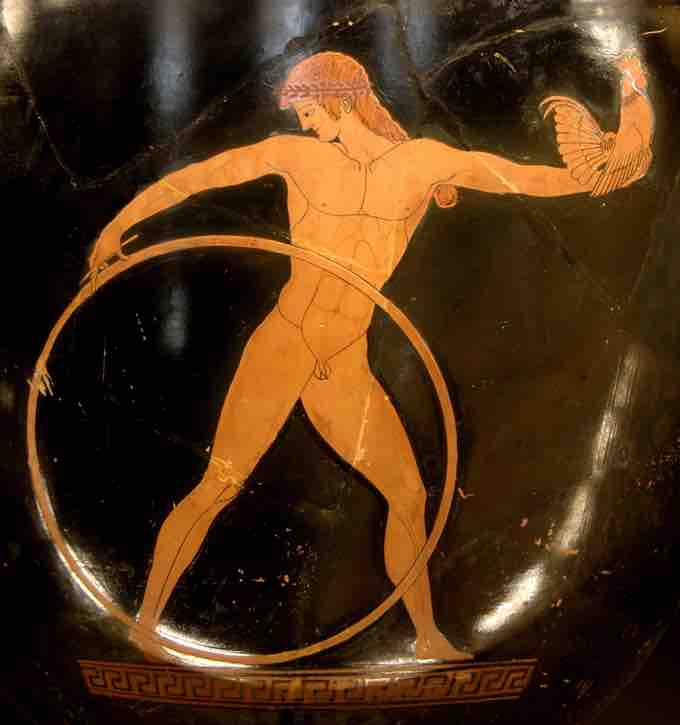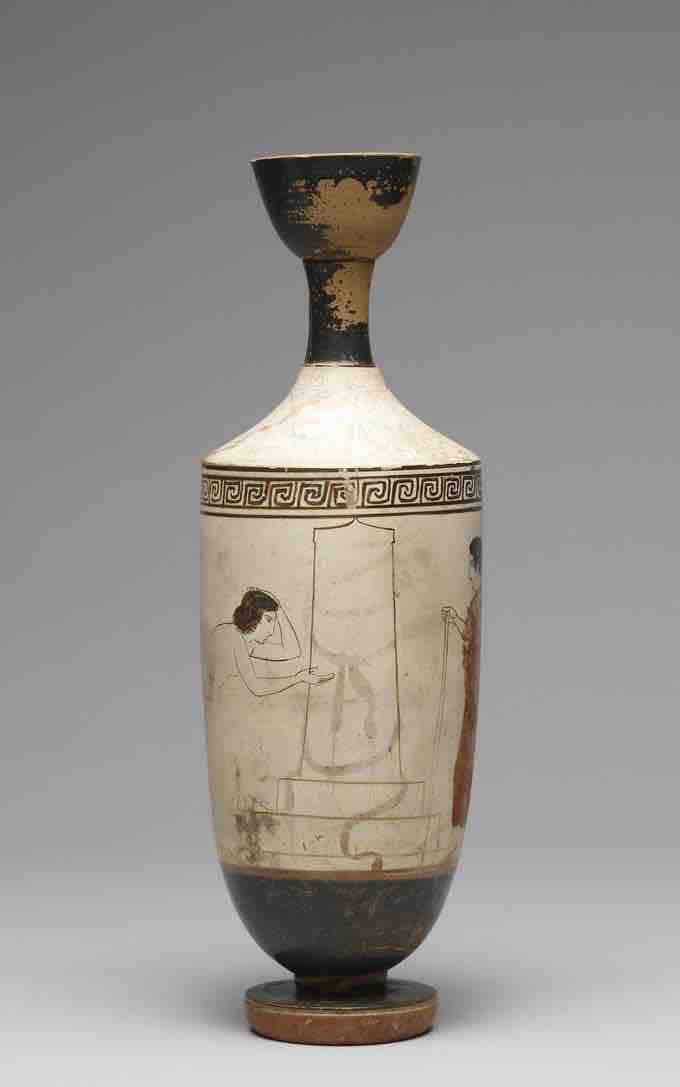The Classical period witnessed the continuation of red- and black-figure painting techniques on ceramic objects. While artists continued to produce black-figure-paintings into the second century BCE, the technique became increasingly rare, overtaken about 520 BCE by red-figure painting. Attic red-figure vases were exported throughout Greece and beyond, and for a long time dominated the market for fine ceramics. Only few centers of pottery production could compete with Athens in terms of its innovation, quality, and production capacity.
Red-Figure Painting
Red-figure painting continued to flourish during the Early, High, and Late Classical periods. The naturalism of the figures in Early Classical vase painting continued to increase, as the figures became less stocky and less linear. Both the figures and their drapery began to appear more plastic, and the scenes often depicted a single moment within a mythical story or event. Furthermore, vase painting began to be influenced by the changes occurring in both sculpture and the large-scale painting of walls and panels.
The "Mannerists" were a group of Attic red-figure painters known for their affected (emotive) subject matter. They were active from about 480 BCE until near the end of the fifth century BCE. Their main characteristic is that they maintained features of black-figure vase painting in the red-figure technique. Their figures seem elongated and have small heads, the garment folds are falling stiff, resembling stairs, and the images are framed with black-figure style ornamentations. The range of motifs is also influenced by previous periods. The figures gesticulate as if using a form of sign language, especially the hands often appear stiff and theatrical. We can see typical Mannerist small heads and affected gestures in the Pan Painter's Herakles Fighting Busiris (c. 470 BCE).
The Pan Painter, Herakles Fighting Busiris
Mannerist red-figure. c. 470 BCE.
The Niobid Painter's red-figure krater of Artemis and Apollo slaying the children of Niobe, from 460 BCE, is believed to be a composition inspired by a panel painting. The side of the vessel depicting Artemis and Apollo relates to the myth of the twin god and goddess who slew Niobe's fourteen children after she boasted that her ability to birth children acceded Leto, the mother of Apollo and Artemis. This story alludes to ancient Greek admonitions against hubris, or extreme pride. The scene is one of the first vase painting scenes to show the figures on different ground lines. Apollo and Artemis stand in the center of the vessel as Niobe's children fall to ground around them. One child has even fallen behind a rock in the landscape. On the other side of the vase is an image of gods and heroes, with Herakles at the center. All the figures stand and sit on various ground lines. The figures on both sides are depicted from multiple angles, including three-quarter view, and a profile eye is used for the figures in profile, a first in Greek vase painting.

Herakles with Gods and Heroes
Niobid Painter. Herakles with Gods and Heroes. Reverse side of the krater depicting Artemis and Apollo slaying the children of Niobe. Athenian red figure calyx krater. c. 450 BCE. Orvieto, Italy.

Artemis and Apollo Slaying the Children of Niobe
Niobid Painter. Artemis and Apollo Slaying the Children of Niobe. Athenian red-figure calyx krater. c. 450 BCE. Orvieto, Italy.
The Berlin Painter is another well-known Early Classical vase painter. His unique style depicted figures, isolated from context, on a small ground line against a glossy black background. His figures also started in the middle of the vase and extended onto the vessel's shoulder, stopping at the neck. He pays particular attention to the details of the body and the drapery of each figure, and allows both figure and drapery to express emotion, space, and movement. His painting entitled Ganymede with a Hoop and Cock conveys a sense of dynamism by arranging the body through a series of diagonal outlines, using contour lines to mark the locations of muscles and tendons beneath the skin.

Ganymede with a Hoop and Cock
Berlin Painter. Ganymede with a Hoop and Cock. Attic red-figure bell krater. c. 500-490 BCE.
White-Ground Painting
White-ground painting developed around 500 BCE and gained popularity during the following century. The technique is based on the use of paints, instead of slip, to create polychrome vessels. The vessels were first coated in a white slip before various colors of paint were added. The white background and firing techniques allowed for various colors to be used, including blue, yellow, red, brown, and green. Because the style is less durable than black- and red-figure painting, it was often used for votives and as grave offerings.
The common outline paintings of the white-ground technique would not dominate they style until approximately the mid-fifth century BCE. For the first 50 years of white-ground painting, known as Type I, the imagery resembled conventional black-figure painting, with the color of the background as the only difference. This depiction of Herakles fighting Geryon provides an example of Type I white-ground painting.
Herakles Fighting Geryon
Herakles (in the center) attacks Geryon (on the far right). Eurytion lays wounded at their feet. Athena (on the left) watches the scene. Attic white-ground black-figure lekythos.
White-ground painting is often seen on a lekythos, a vessel used to hold oils, which were sometimes used for anointing the dead. Due to this funerary function, lekythoi were also used as grave offerings. As such, many of the scenes painted on white ground lekythoi depict or allude to funerary scenes (such as funerary rites and rituals) or images of warriors departing their wives for battle and death. While the scene of Herakles fighting Geryon depicts a rather violent prelude to death, the imagery on later lekythoi is somewhat more sedate.

Woman Attending a Tomb
Thanatos Painter. Woman Attending a Tomb. Attic white ground lekythos. c. 440-430 BCE.
The Achilles Painter, a pupil of the Berlin Painter and creator of both red-figure and white-ground vessels, is one of the most well-known white ground painters. The scenes he painted on his white-ground lekythoi are filled with pathos and sorrow, often depicting women sitting in front of grave stelae or bidding their battle-bound husbands farewell.
Muse with Lyre
Achilles Painter. Muse with Lyre. Attic white ground lekythos. c. 440-430 BCE.
Overall, in both white-ground and red-figure painting during the Early Classical period, the form of the body was perfected by the artisans. Painted vessels were now depicting figures on a two-dimensional plane, with the illusion of three-dimensional space. These figures were rendered in that space naturally, in terms of their movement and form. Black-figure painting nearly disappeared in the Early Classical period and was primarily reserved for objects made to seem old or recall antique styles, such as victory amphorae for the Panhellenic Games.